Table Of Content
- Understanding the Importance of High-Altitude Tent Pitching
- Challenges of High-Altitude Tent Pitching
- Benefits of Proper Tent Pitching Techniques
- Choosing the Right Tent for Mountain Camping
- Consider the Following Factors
- Types of Tents
- Essential Tools and Equipment for Tent Pitching at High Altitudes
- The Must-Have Tools
- Essential Equipment for High-Altitude Camping
- Locating the Perfect Campsite for Mountain Camping
- Scout the Area
- Consider the View
- Privacy Matters
- Proximity to Water
- Factor in Wind Direction
- Step-by-Step Guide to Setting Up Your Tent in High Altitudes
- Securing a Solid Foundation
- Unfolding and Assembling
- Anchoring in Extreme Conditions
- Adjusting for Altitude
- Adding Protective Layers
- Testing for Stability
- Tips for Securing Your Tent in Windy Conditions
- Choose the Right Spot
- Anchor it Down
- Use Guy Lines
- Reinforce with Rocks
- Opt for a Low Profile
- Maintaining Your Tent and Gear for High-Altitude Adventures
- Protecting Your Shelter
- Caring for Your Gear
- Effective Ways to Stay Warm and Comfortable in Your Mountain Tent
- Layer Up for Maximum Warmth
- Invest in Thermal Gear
- Use Hot Water Bottles
- Dealing with Common Challenges in High-Altitude Tent Pitching
- Thin Air, Strong Winds
- Changing Weather Conditions
- Uneven Ground and Rocky Terrain
- Temperature Fluctuations
- Advanced Techniques for Mastering Tent Pitching at High Altitudes
- Optimizing Guyline Placement
- Utilizing Snow Anchors
- Understanding Windbreaks
- Frequently Asked Questions (FAQs)
Welcome, fellow adventurers and nature enthusiasts! Today, we delve into the exhilarating world of mountain camping and the essential skill of high-altitude tent-pitching techniques. As an experienced mountaineer who has conquered numerous peaks and witnessed the majesty of high-altitude landscapes, I understand the critical importance of properly setting up camp in such challenging environments.
Mastering the art of tent pitching at high altitudes is more than just a practical skill; it is a testament to our resilience and adaptability in the face of nature’s raw power. Whether you are a seasoned camper or a novice explorer looking to embark on your first mountain camping expedition, understanding the unique challenges and techniques involved in setting up a tent in high-altitude conditions is crucial for a safe and enjoyable outdoor experience.
In this guide, we will explore the best practices for selecting a campsite, securely anchoring your tent to withstand strong winds, and adjusting to the thinner air at higher elevations. By honing your high-altitude tent-pitching skills, you enhance your camping experience and ensure safety and comfort during mountain adventures.
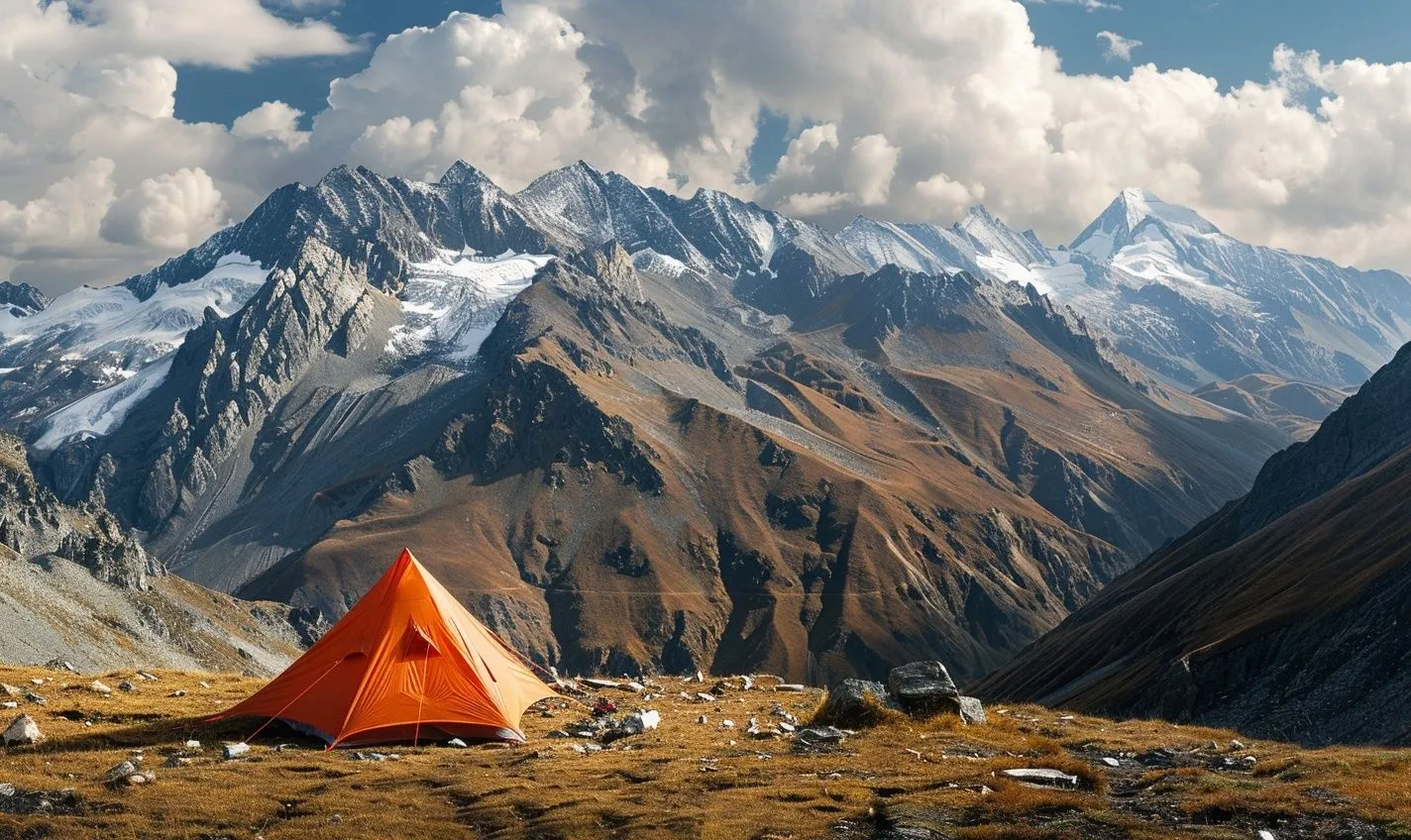
Understanding the Importance of High-Altitude Tent Pitching
Mountain camping offers a unique blend of serenity and challenge, allowing you to disconnect from the hustle and bustle of daily life while immersing yourself in nature’s beauty. Amidst the towering peaks and crisp mountain air, setting up your tent correctly becomes crucial for a safe and comfortable adventure. Let’s delve into the significance of mastering high-altitude tent-pitching techniques.
Challenges of High-Altitude Tent Pitching:
The conditions can be unpredictable and harsh at higher elevations, making it essential to pitch your tent with precision and care. Here are some reasons why high-altitude tent pitching is paramount:
- Strong winds can easily dislodge a poorly pitched tent.
- The temperature drops dramatically at night, requiring a well-insulated shelter.
- Thin air at high altitudes may affect your judgment and physical abilities.
Benefits of Proper Tent Pitching Techniques:
When you master the art of pitching your tent effectively in mountainous terrain, you unlock a world of advantages that enhance your camping experience. These benefits include:
- Increased stability and security against harsh weather conditions.
- Enhanced comfort and warmth during chilly nights.
- Peace of mind knowing your shelter is resilient to mountain challenges.
Honing your high-altitude tent-pitching skills will ensure your safety and elevate your overall camping enjoyment amidst stunning mountain landscapes. Stay tuned for practical tips and techniques for excelling in setting up your tent at high altitudes.
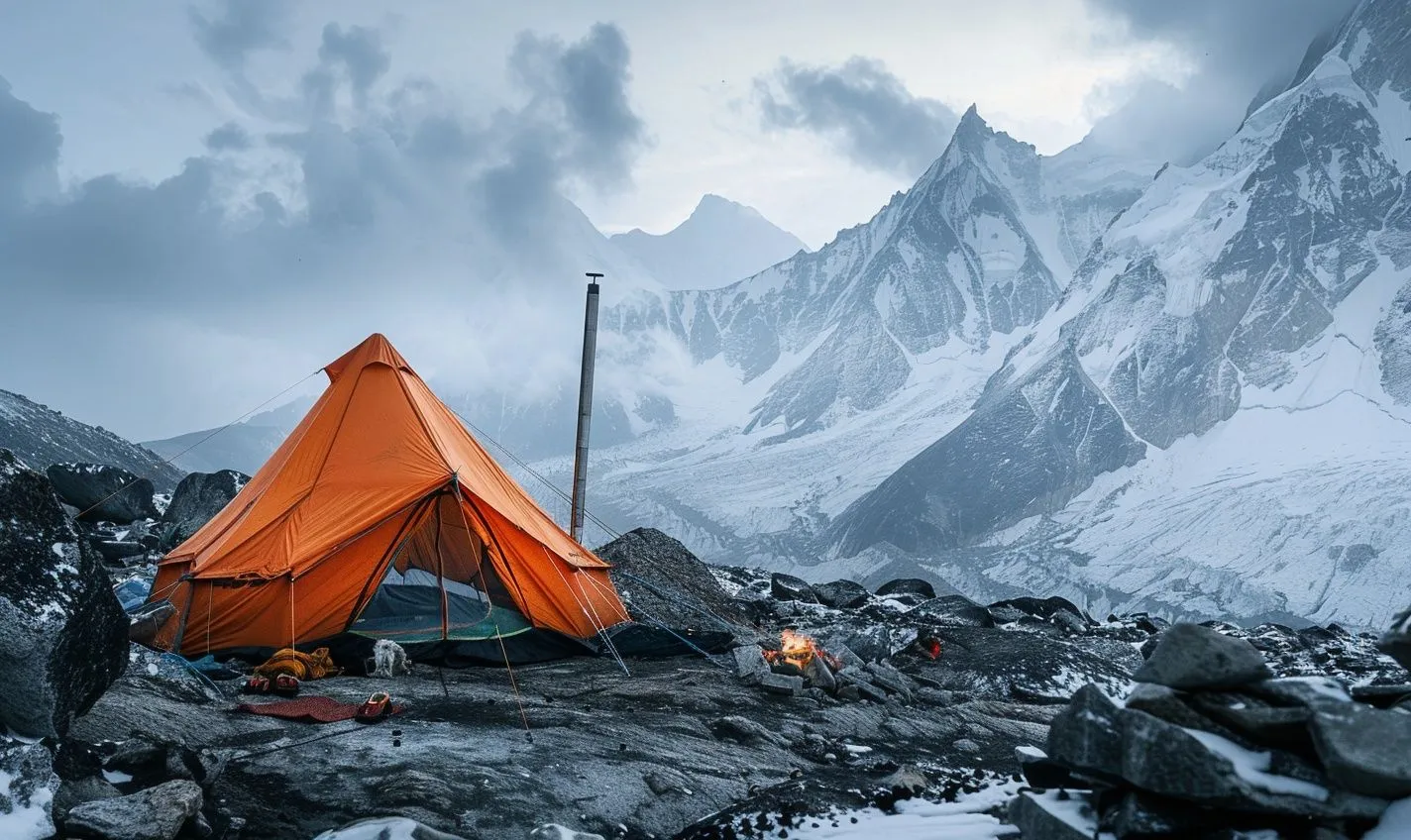
Choosing the Right Tent for Mountain Camping
When venturing into the wilderness for a mountain camping trip, your tent becomes your sanctuary, your shield against the elements. So, how do you choose the perfect tent for your high-altitude adventure?
Consider the Following Factors:
1. Durability: Look for a tent made from rugged materials that can withstand harsh mountain conditions.
2. Weight: Opt for a lightweight tent as you’ll need to carry it to your campsite.
3. Size: Ensure the tent is spacious enough to accommodate you comfortably.
4. Season Rating: Choose a tent suitable for your camping seasons.
Types of Tents:
1. Three-Season Tents: These tents are perfect for most mountain camping trips, offering a balance of ventilation and weather protection.
2. Four-Season Tents: Ideal for extreme weather conditions, designed to withstand heavy snow and strong winds.
3. Ultralight Tents: Great for backpackers due to their lightweight design, but may sacrifice some durability.
Remember, your tent is your home away from home in the mountains. Choose one that suits your needs and provides the comfort and protection you require during your high-altitude adventure.
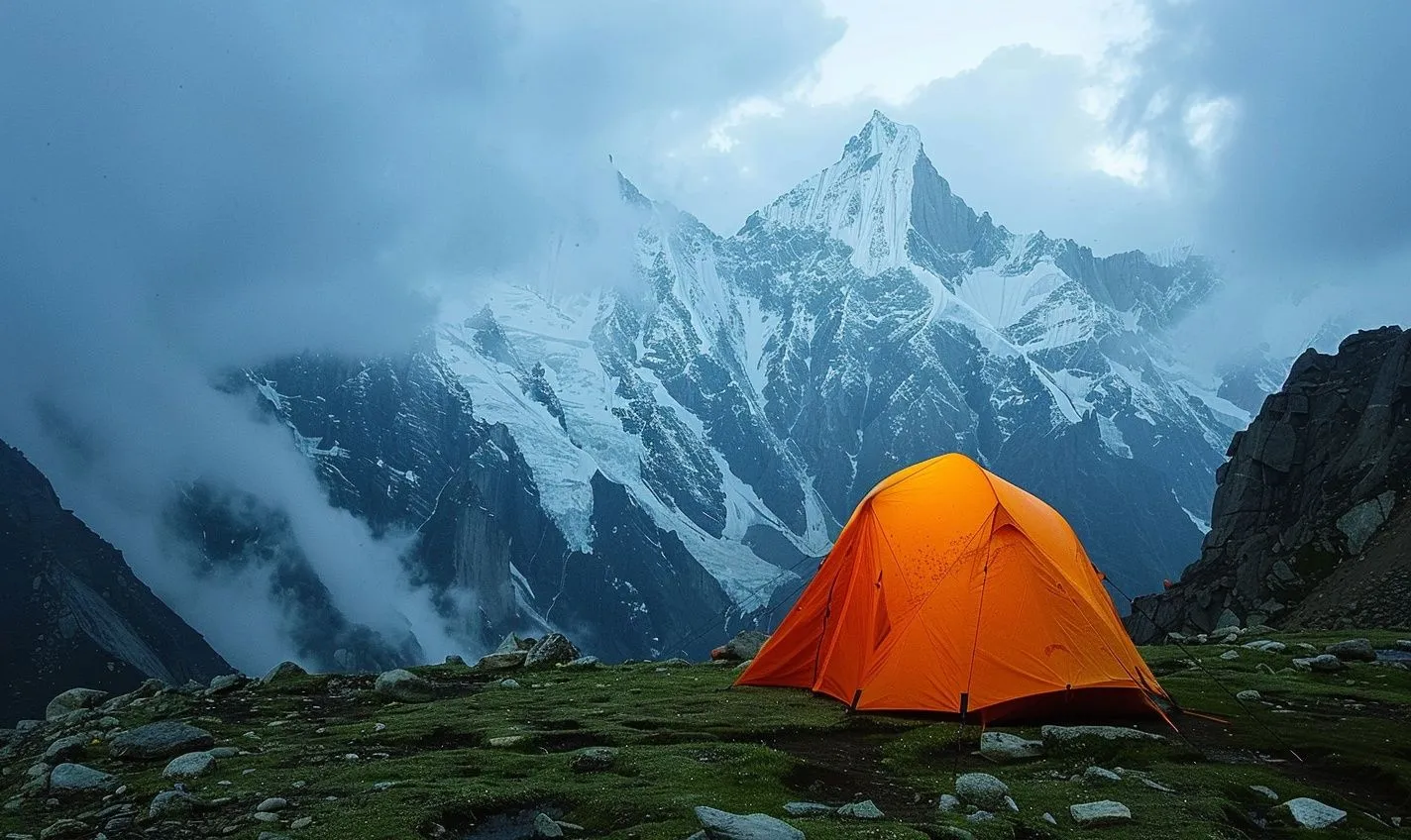
Essential Tools and Equipment for Tent Pitching at High Altitudes
Regarding mountain camping, high-altitude tent-pitching techniques are crucial for a successful outdoor adventure. The right tools and equipment are essential to ensure a safe and comfortable camping experience in the mountains. Let’s take a look at what you need:
The Must-Have Tools:
- Tent: Choose a sturdy, lightweight tent for high altitudes to withstand wind and unpredictable weather.
- Tent Stakes: Invest in quality stakes to secure your tent firmly to the ground.
- Hammer or Mallet: Help you drive stakes into the ground with ease.
- Tent Repair Kit: Carry a repair kit to fix any tears or damages to your tent quickly.
Essential Equipment for High-Altitude Camping:
- High-Quality Sleeping Bag: Keep yourself warm and cozy during cold mountain nights.
- Sleeping Pad: Provide insulation from the cold ground and ensure a comfortable night’s sleep.
- Headlamp or Flashlight: Essential for navigating around your campsite in the dark.
- Camp Stove and Fuel: Prepare hot meals and beverages to energize you during your mountain adventure.
Don’t forget to pack extra ropes, guylines, and a multitool for various campsite tasks. These tools and equipment will make tent pitching easier and enhance the mountain camping experience.
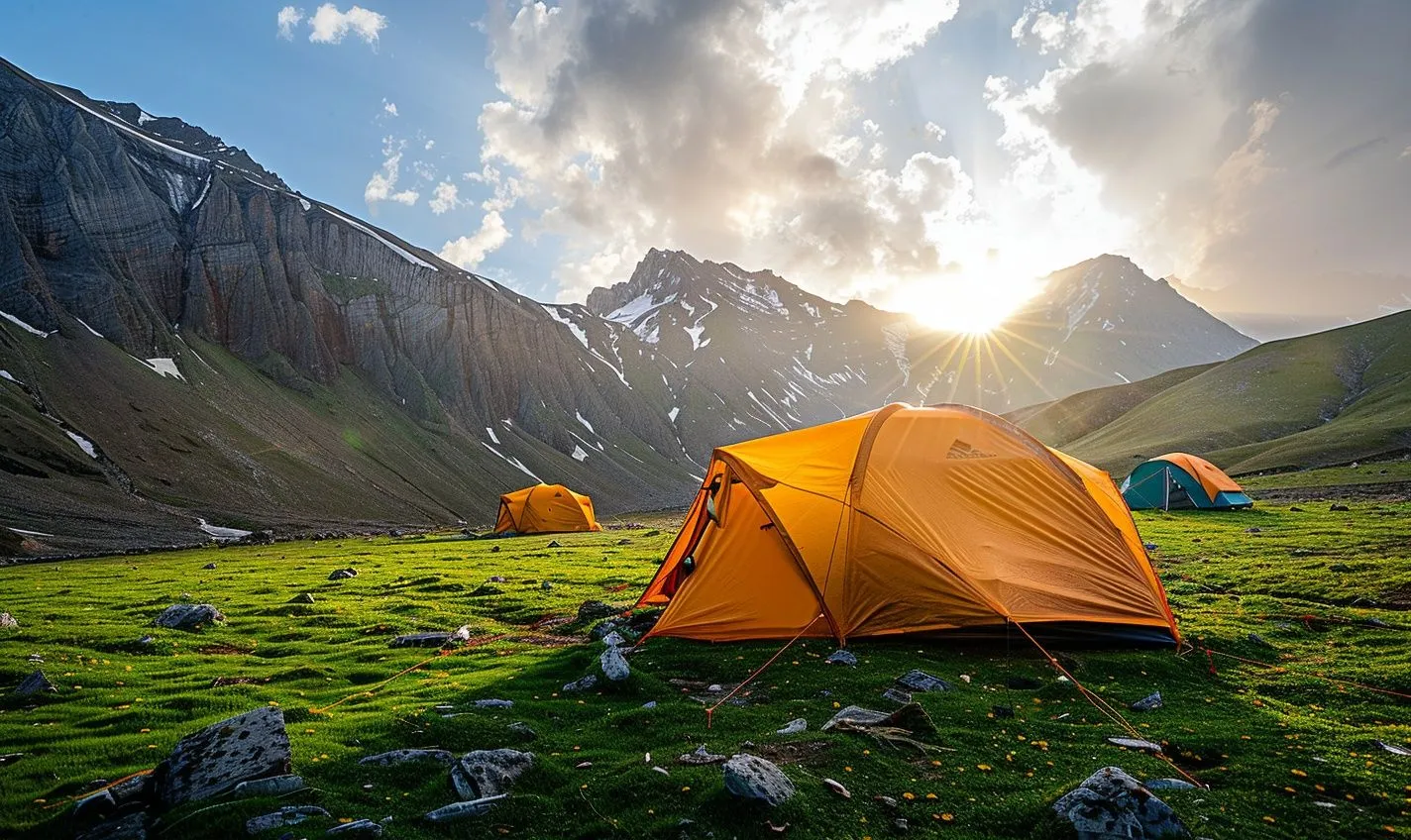
Locating the Perfect Campsite for Mountain Camping
When it comes to mountain camping, the location of your campsite can make or break your entire experience. Picture this: waking up to the sun peeking over snow-capped peaks, the crisp mountain air filling your lungs, and the tranquility of nature enveloping you. To achieve this idyllic setting, follow these tips for finding the ultimate spot:
Scout the Area
Before you start setting up your tent, take a stroll around the area. Look for a flat, elevated spot that is well-drained to avoid waking up in a puddle if it rains.
Consider the View
Find a campsite that offers breathtaking views. Imagine unzipping your tent to a panorama of majestic mountain ranges stretching out before you.
Privacy Matters
Ensure your campsite is secluded enough to give you a sense of privacy. You don’t want to feel like you’re on display for other campers passing by.
Proximity to Water
While it’s essential to be close to a water source for drinking and cooking, make sure you’re at a safe distance to avoid potential flooding during heavy rain.
Factor in Wind Direction
Consider the prevailing wind direction and orient your tent so that the entrance faces away from the wind. This simple adjustment can make a huge difference in your camping comfort.
Remember, mountain camping is not just about surviving; it’s about thriving in the beauty of nature. Choosing the perfect campsite can elevate your camping experience from ordinary to extraordinary.
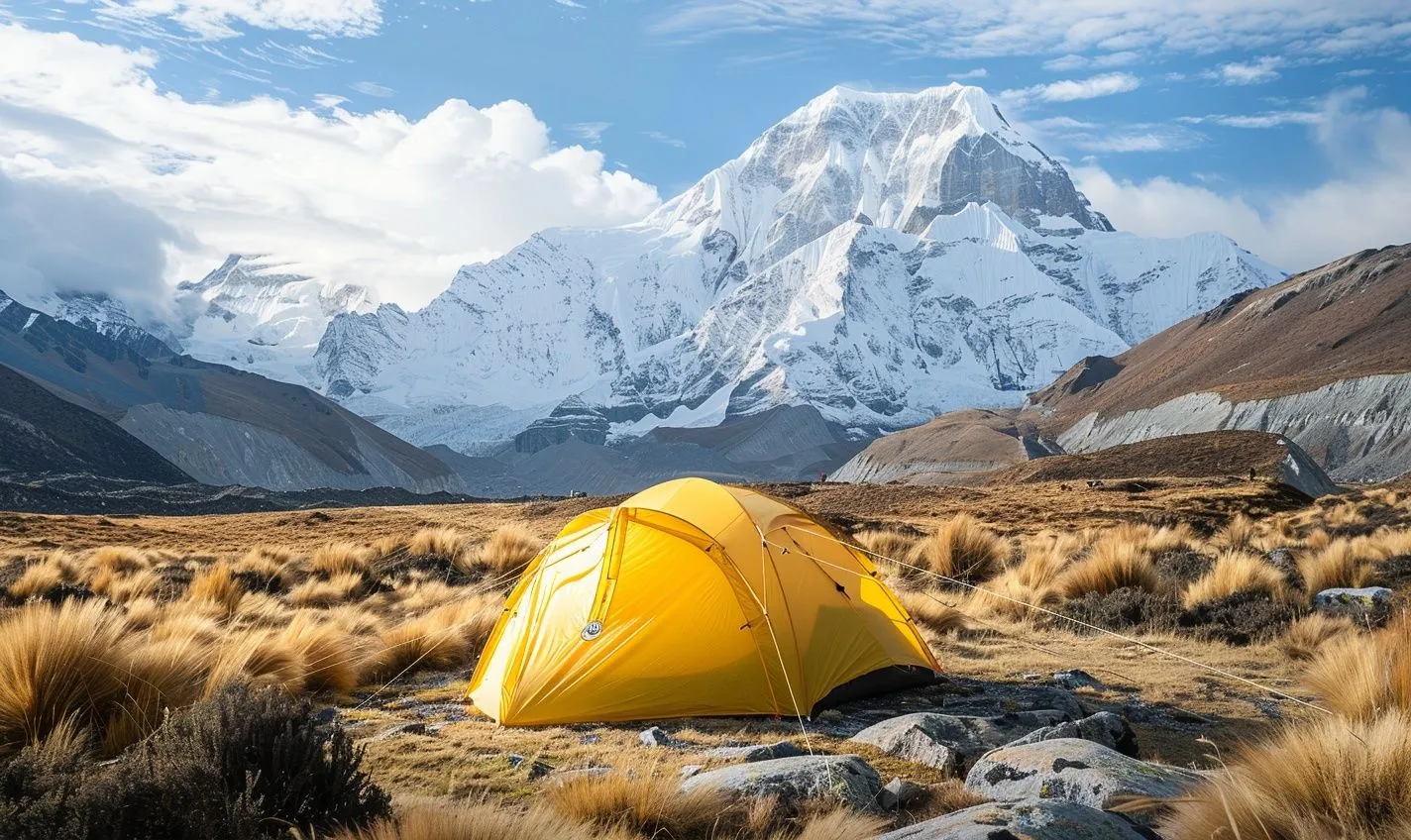
Step-by-Step Guide to Setting Up Your Tent in High Altitudes
When camping in breathtaking mountains, setting up your tent correctly is crucial for a comfortable and safe stay. Let’s explore a step-by-step guide to pitching your tent at high altitudes to ensure a successful camping experience.
Securing a Solid Foundation
Start by clearing the area of sharp rocks or branches that could damage your tent floor. Secure a flat spot against solid winds with rocks or tent stakes.
Unfolding and Assembling
Unpack your tent and lay it flat on the ground. Follow the instructions to assemble the poles and attach them to the tent body. Properly stake out the corners to keep the tent taut.
Anchoring in Extreme Conditions
Winds can get intense in high-altitude areas. Use additional guy lines to anchor your tent further and prevent it from being blown away.
Adjusting for Altitude
Remember that altitude affects air pressure, which can cause your tent to feel tighter. Adjust the tension of the tent fabric and guy lines to accommodate these changes.
Adding Protective Layers
Consider using a footprint or ground underneath your tent to provide extra insulation, protect the floor from sharp objects, and keep moisture at bay.
Testing for Stability
Once your tent is set up, please gently shake it to ensure it’s securely anchored. Check the guy lines and stakes regularly to make adjustments if needed.
And there you have it! Following these steps and guidelines, you can pitch your tent like a pro in high-altitude mountain camping scenarios. Enjoy the stunning views and fresh air, knowing your shelter is secure and ready for adventure.
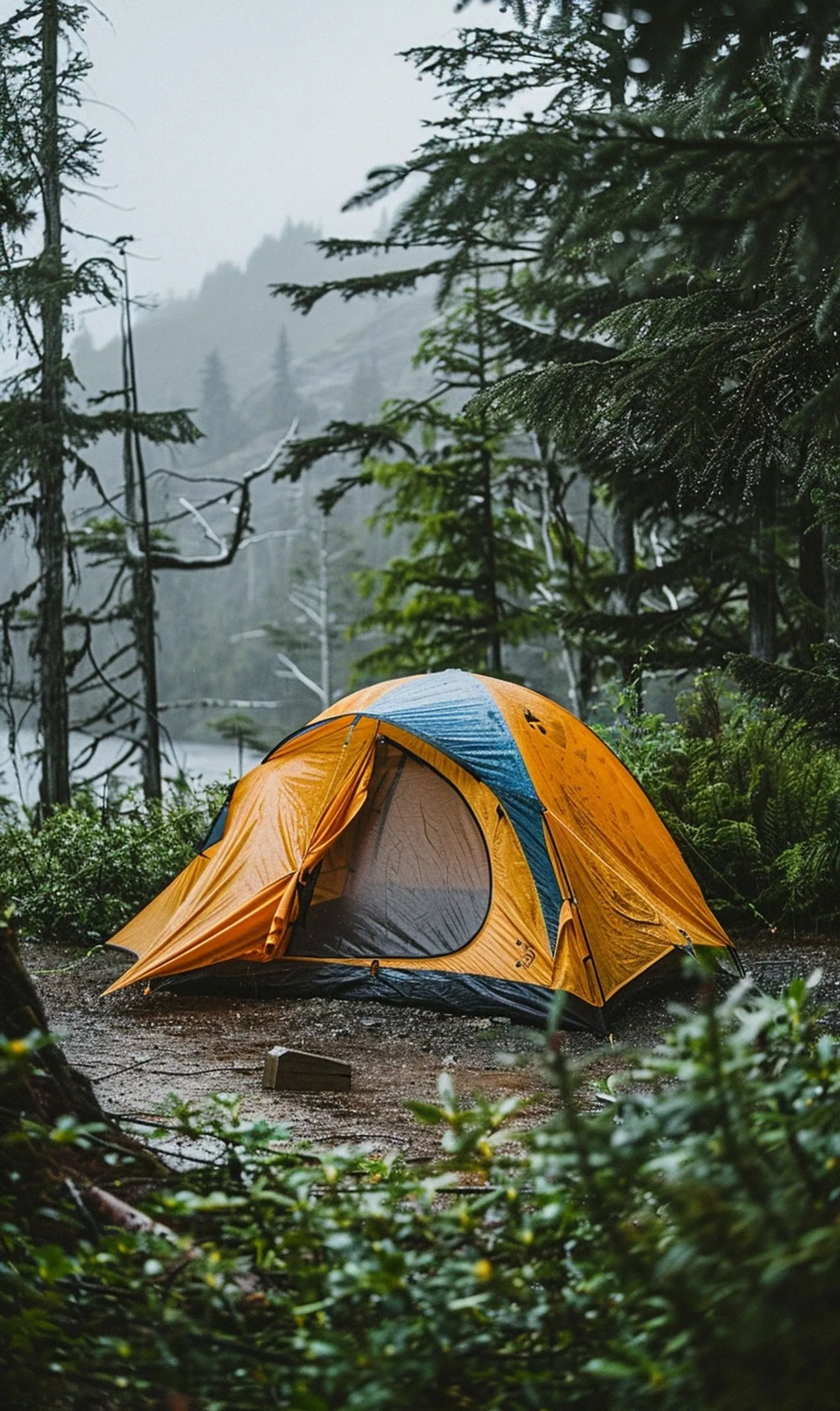

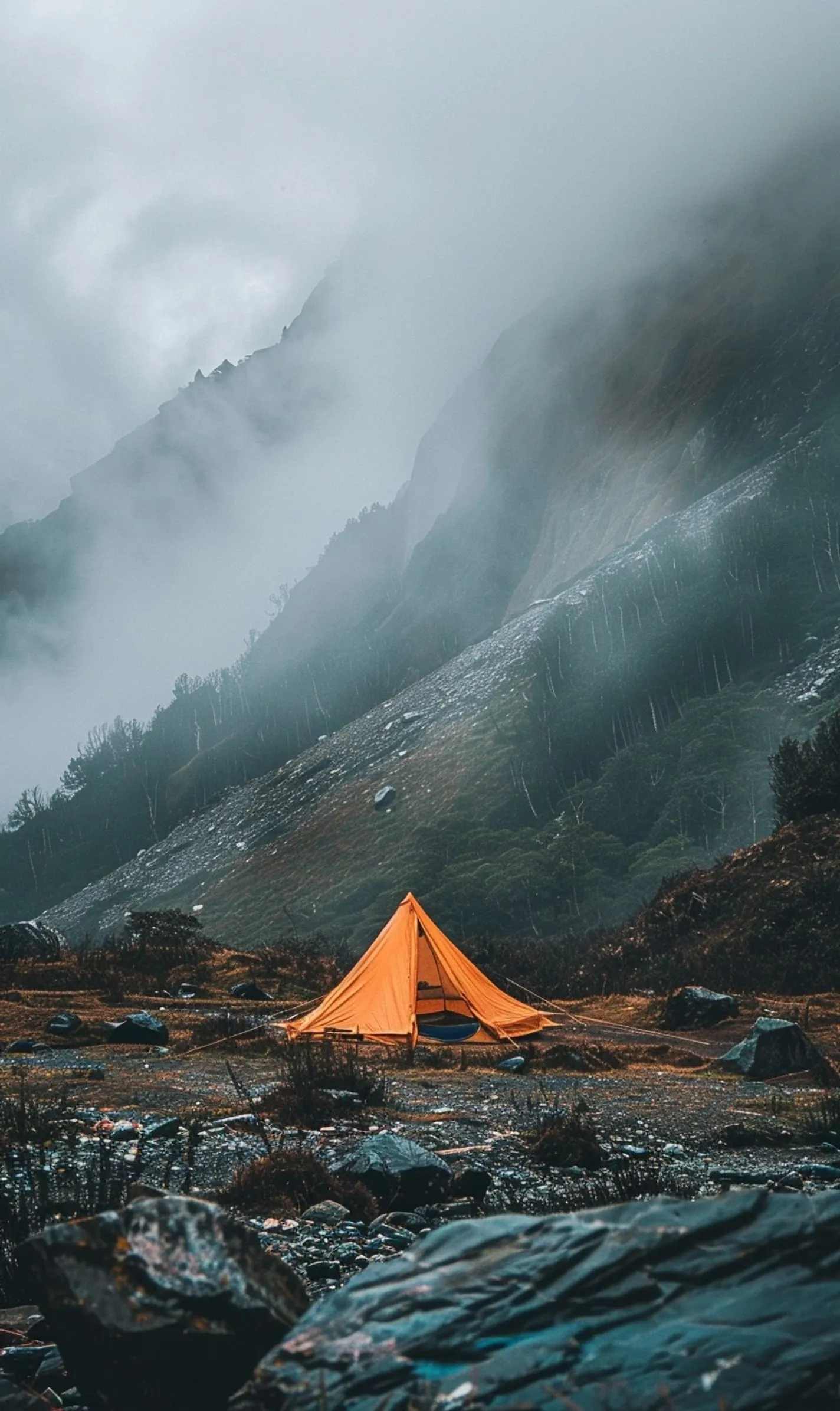
Tips for Securing Your Tent in Windy Conditions
Wind can be a camper’s worst enemy, especially when you’re out in the mountains. A sudden gust can turn your peaceful camping trip into a chaotic mess, sending your tent flying. But fear not! Following some handy tips, you can ensure your shelter stays put even in the windiest conditions.
Choose the Right Spot
Before setting up your tent, scout the area for a location shielded from the brunt of the wind. Look for natural barriers like trees, rocks, or hills that can act as windbreaks.
Anchor it Down
Secure your tent with stakes or heavy rocks to prevent it from lifting off the ground. Drive the stakes at a downward angle for maximum hold.
Use Guy Lines
Attach extra guy lines to your tent’s rainfly and stake them out in multiple directions. This will distribute the wind force evenly, keeping your tent stable.
Reinforce with Rocks
Place large rocks on top of the stakes to provide additional weight and prevent them from being pulled out of the ground by strong gusts.
Opt for a Low Profile
Consider setting up your tent with a low profile, meaning closer to the ground. This reduces the surface area exposed to the wind, making it less likely to catch and lift.
Facing windy conditions while camping can be challenging, but with these tips, you’ll be better equipped to handle whatever Mother Nature throws. Remember, a well-secured tent ensures a good night’s sleep and keeps you safe and comfortable throughout your high-altitude adventure.
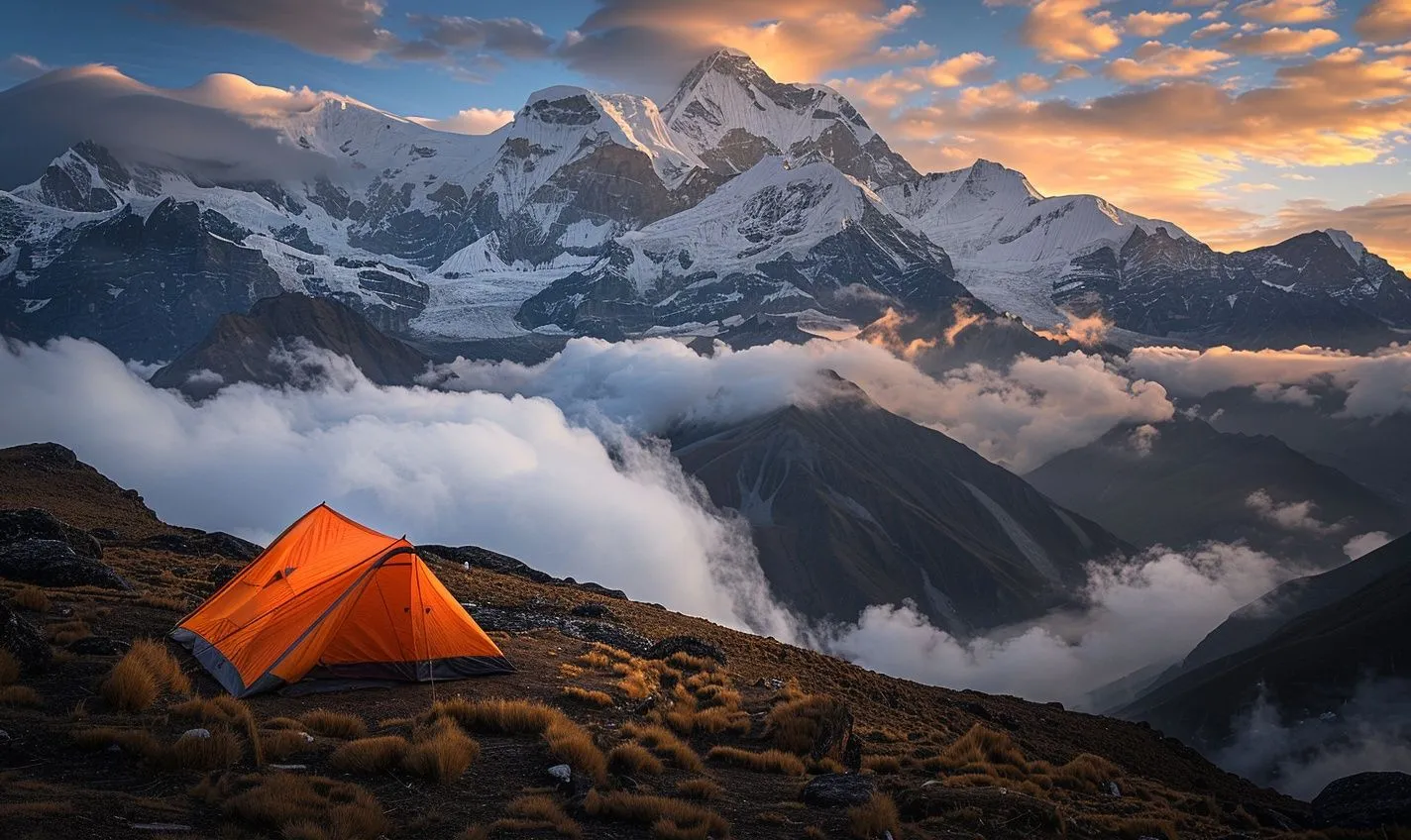
Maintaining Your Tent and Gear for High-Altitude Adventures
So, you’ve conquered the art of setting up your tent in the high mountains, but your adventure has just begun. Now, let’s dive into maintaining your tent and gear to ensure a safe and enjoyable camping experience at high altitudes.
Protecting Your Shelter:
And just like that, your trusty tent becomes your home away from home when exploring the rugged terrain of the mountains. But how can you keep it in top condition?
1. Regular Inspections: Take a few minutes daily to check for any tears, loose seams, or broken zippers.
2. Cleaning: Keep your tent clean from dirt, debris, and moisture accumulation to prevent mold and mildew.
3. Storage: Always dry your tent correctly before storing it to avoid musty odors and damage.
Caring for Your Gear:
Your gear is your lifeline in the mountains; maintaining it is paramount to your safety and comfort.
1. Proper Packing: Organize and pack your gear neatly to prevent damage and ensure easy access when needed.
2. Regular Maintenance: Check your equipment for wear and tear, particularly your sleeping bag, stove, and backpack.
3. Weather Protection: Invest in waterproofing sprays for your gear to keep them dry during unexpected mountain showers.
Now that you’ve equipped yourself with the knowledge to maintain your tent and gear for high-altitude adventures, go out there and embrace the challenges of mountain camping with confidence. Remember, a well-maintained shelter and gear can make all the difference between a memorable adventure and a challenging ordeal. So, take care of your gear, respect the mountains, and let the wilderness guide you on your next journey.
Effective Ways to Stay Warm and Comfortable in Your Mountain Tent
When camping in the mountains, the temperatures can drop significantly, making staying warm and comfortable in your tent essential. While proper tent-pitching techniques help keep the elements at bay, there are additional strategies you can employ to enhance your camping experience.
Layer Up for Maximum Warmth
Just like dressing in layers keeps you warm outdoors, layering your sleeping arrangements can make a significant difference on chilly mountain nights. Ensure you have a good-quality sleeping bag rated for cold temperatures, and consider using a sleeping pad for insulation from the ground.
Invest in Thermal Gear
Thermal clothing, socks, and hats can be a game-changer when staying warm in your tent. These items trap heat close to your body, preventing it from escaping and keeping you cozy throughout the night.
Use Hot Water Bottles
Before bedtime, fill a leak-proof water bottle with hot water and place it at the foot of your sleeping bag. The heat from the bottle will radiate throughout the bag, creating a toasty cocoon for you to snuggle into.
And why not brew a warm beverage before hitting the sack? A cup of hot chocolate or tea can warm you up from the inside out, helping you relax and unwind after a day of mountain adventures.
Remember, staying warm in your mountain tent is not just about physical comfort; it’s about creating a sense of security and coziness that allows you to enjoy nature’s beauty.
Dealing with Common Challenges in High-Altitude Tent Pitching
So, you’ve reached the majestic mountain peak, ready for a night under the stars. But as you start setting up your tent, challenges can arise. Let’s tackle these common hurdles together:
Thin Air, Strong Winds
High-altitude camping often involves dealing with thin air and unpredictable winds, making it difficult to keep your tent standing tall. Embrace the challenge using extra guy lines and sturdy stakes to secure your shelter.
Changing Weather Conditions
Mountains create their weather patterns. You may experience sudden rain, snow, or intense sunlight. Prepare for all scenarios by selecting a tent with excellent weather resistance and ventilation. Stay adaptable and ready for anything nature throws at you.
Uneven Ground and Rocky Terrain
Mountains are not known for their flat, soft surfaces. Picking a suitable campsite can make a world of difference. Look for areas with moderate slopes that are clear of large rocks. Remember, comfort comes from knowing how to level your tent on uneven terrain.
Temperature Fluctuations
As the sun sets behind the peaks, temperatures drop rapidly. Dressing in layers and bringing a quality sleeping bag for colder temperatures can keep you snug throughout the night. Embrace the chill as part of the exhilarating mountain experience.
Camping at high altitudes is an adventure like no other. Embrace the challenges, for they are what make the experience truly rewarding. Mastering the art of tent pitching in mountainous terrain requires patience, adaptability, and a dash of courage. So, gear up, venture into the unknown, and let the mountains weave their magic around you.
Advanced Techniques for Mastering Tent Pitching at High Altitudes
As you progress in your mountain camping adventures, mastering the art of tent pitching at high altitudes becomes crucial. The terrain is rugged, the weather unpredictable, and your safety is paramount. Here are some advanced techniques to elevate your tent pitching game:
Optimizing Guyline Placement
Mountain camping often involves dealing with strong winds. Strategically placing your guylines at the right angles can significantly enhance your tent’s stability. Remember, a well-secured tent is a reliable shelter.
Utilizing Snow Anchors
When pitching a tent on snow-covered surfaces, traditional stakes may not suffice. Snow anchors, like deadman anchors or snow stakes, provide the necessary grip to withstand frosty conditions. They are your best ally in creating a solid foundation for your shelter.
Understanding Windbreaks
Creating natural or artificial windbreaks around your campsite can shield your tent from strong gusts. Utilize rocks, fallen trees, or even your vehicle to minimize wind impact on your tent. The less your tent fights against the wind, the more secure it remains.
Mastering tent pitching at high altitudes is a continuous learning process. Each camping experience presents new challenges and opportunities for growth. Remember, practice makes perfect.
Conclusion
Congratulations on mastering high-altitude tent-pitching techniques for mountain camping! By understanding the unique challenges and considerations of camping at high altitudes, you have equipped yourself with valuable skills to ensure a safe and enjoyable camping experience.
Proper tent placement, securing guy lines, and using suitable stakes are crucial in withstanding windy and unpredictable mountain weather. Rock and snow anchors will add stability and security to your tent structure.
Always be prepared to adapt and improvise based on the specific conditions of the mountain environment you are camping in. This flexibility and willingness to adjust your tent setup will be vital in overcoming any unexpected challenges.
By following the tips and techniques in this guide, you are on your way to becoming a proficient high-altitude camper. Embrace the adventure, respect nature, and continue honing your camping skills for many more memorable mountain expeditions!
Frequently Asked Questions (FAQs)
Q: What are high-altitude tent pitching techniques?
A: High-altitude tent pitching techniques involve securing your tent properly in windy conditions, choosing a sheltered spot, and utilizing sturdy tent stakes.
Q: How do I prevent my tent from getting damaged in high-altitude camping?
A: To prevent tent damage, use a high-quality tent suitable for high altitudes, check weather forecasts, and adequately secure all tent components.
Q: What types of tents are best for mountain camping?
A: Dome tents or geodesic tents are popular choices for mountain camping due to their stability and ability to withstand harsh weather conditions.
Q: How can I ensure my tent stays warm at high altitudes?
A: To keep warm at high altitudes, use a four-season tent with a rainfly, ground cloth or footprint to insulate from the cold ground, and quality sleeping bags and pads.
Q: Should I use guylines when setting up my tent in the mountains?
A: Guylines can help stabilize your tent and prevent it from swaying or collapsing in windy mountain conditions.
Q: What are some essential tips for pitching a tent in rocky terrains?
A: When pitching a tent on rocky terrain, look for flat surfaces, use a footprint or tarp to protect the tent floor, and consider using rocks to anchor the guylines.







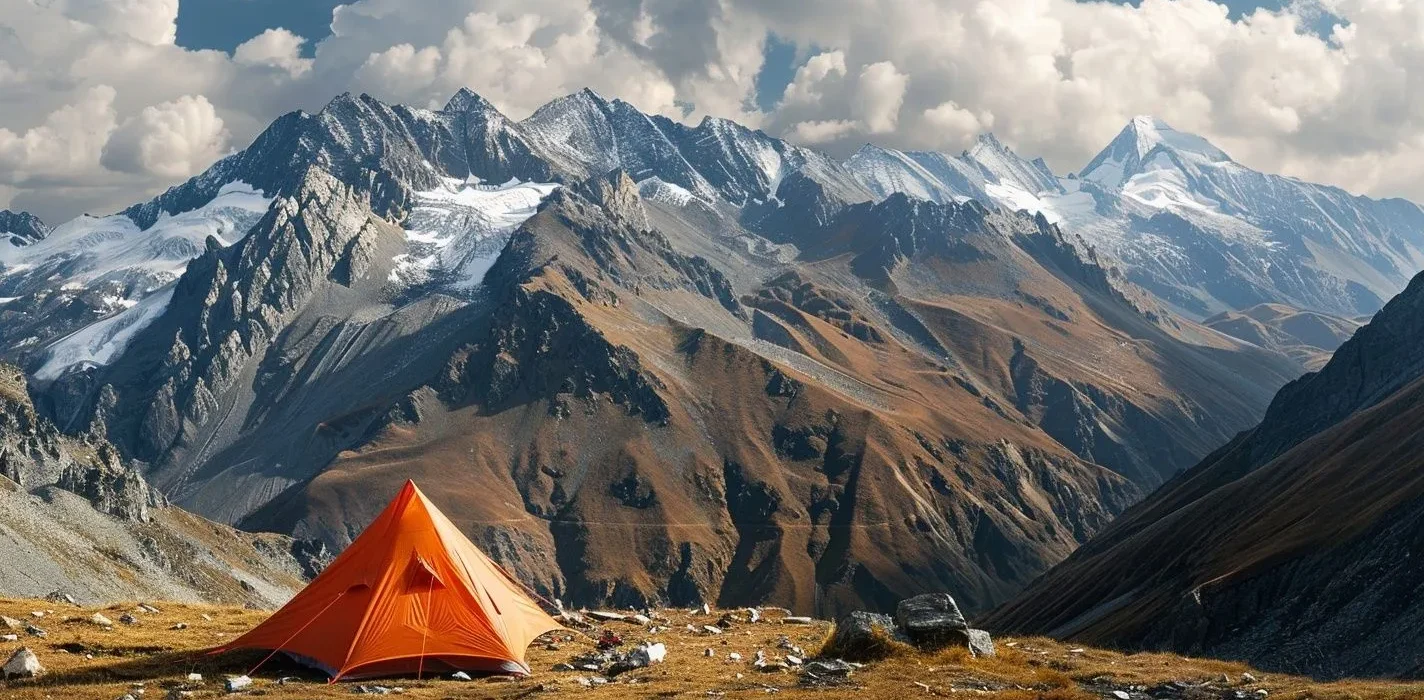


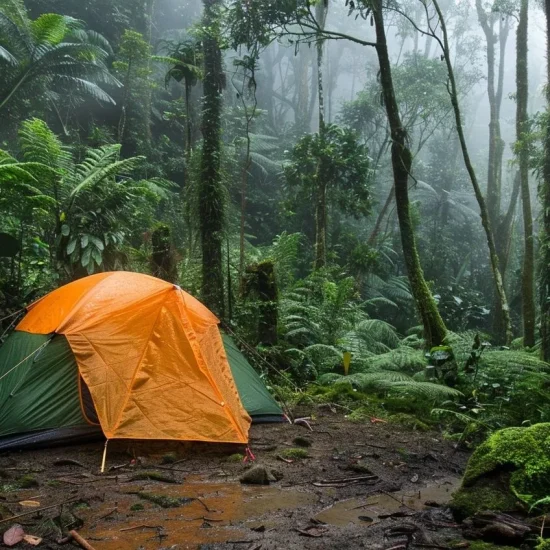
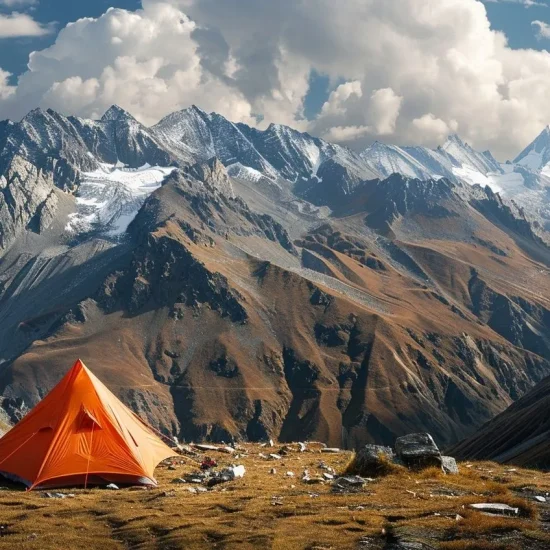
No Comment! Be the first one.